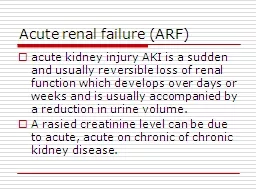

acute kidney injury AKI is a sudden and usually reversible loss of renal function which develops over days or weeks and is usually accompanied by a reduction in urine volume A rasied creatinine level can be due to acute acute on chronic of chronic kidney disease ID: 908134
Download Presentation The PPT/PDF document "Acute renal failure (ARF)" is the property of its rightful owner. Permission is granted to download and print the materials on this web site for personal, non-commercial use only, and to display it on your personal computer provided you do not modify the materials and that you retain all copyright notices contained in the materials. By downloading content from our website, you accept the terms of this agreement.
Slide1
Acute renal failure (ARF)
acute kidney injury AKI is a sudden and usually reversible loss of renal function which develops over days or weeks and is usually accompanied by a reduction in urine volume.
A rasied creatinine level can be due to acute, acute on chronic of chronic kidney disease.
Slide2Two small kidneys on ultrasound indicate chronicity.
Slide3Causes of ARF
Pre renal
Systemic
Heart failure
Blood/ fluid loss/ shock called hypovolemia
Local
Renal artery stenosis
Disease affecting arterioles
Under perfusion initially causes rapidly reversible changes,. Subsequently, acute tubular necrosis that may lead to intrinsic renal failure.
Slide4Intrinsic renal disease
Toxic /septic renal failure 85%
glomerular diseases 5%
Primary
Component of systemic disease
Interstitial disease 10%
Slide5Post renal causes
Obstruction
Stones
Tumor
Enlarged prostate
Slide6Reversible pre renal acute renal failure
Slide7Pathogenesis
The kidneys can regulate its own blood flow and GFR over a wide range of perfusion pressure
When the perfusion pressure falls—as in hypovolaemia, shock, heart failure or narrowing of renal arteries—the resistance vessels in kidneys dilate. It is mediated by prostaglandins.
(this is impaired by NSAIDS)
Slide8if autoregualtion of blood is fails, the GFR can stillbe maintained by selective constriction of efferent arteriols by rennin angiotensin mechanism ( it is inhibited by ACE inhibitors)
Slide9More sever or prolonged under perfusion of kidneys may lead to failure of these compensatory responses, and acute fall in GFR. This leads to formation of low volume concentrated urine (osmolality >600mOsm/kg) but low in sodium (<20mmol/l)
Note these changes may be absent in patient with pre existing renal impairment or those who received diuretics
Slide10Clinical features:
Marked hypotension
Signs of hypoperfusion such as delayed capillary return, cool peripheries etc.
Postural hypotension is reliable sign of early hypovolemia.
Slide11The causes reduces renal hypo perfusion
The sign suggesting following may be present
Shock
Blood loss
Crush injuries
Burns
Sepsis
These causes should be assessed
Slide12Management
Establish and correct the under lying causes is very important step.
Treat hypovolemia with restore blood volume as soon as possible ( with blood, plasm, isotonic saline 0.9%)
Optimize systemic haemodynamics. Monitoring the central venous pressure and pulmonary wedge pressure is necessary for fluid administration.
Note: Meta analysis trials do not support the role of low dose dopamine in ARf.
Correct the metabolic acidosis
Restoring the blood volume will correct the acidosis by restoring the kidney function.
Sodium bi carbonate (50 ml of 8.4%) may be used severe acidosis.
Slide13Prognosis
Good full recovery of renal function if early treatment is given.
In some case treatments is ineffective and renal failure becomes established.
Slide14Established acute renal failure (ARF)
Acute renal failure (ARF) may develop follwing severe and prolonged underperfusion of kidneys when the histological pattern of acute tubular necrosis is usually seen.
Acute tubular necrosis (ATN)
It is necrosis of renal tubular cells may result from ischemia of nephrotoxicity caused by chemicals, bacterial toxins or combination.
Slide15Drugs includes
Aminoglycosides antibiotics like gentamicin, the cytotoxic drugs cisplastin, anti fungal amphotericin B.
Slide16Fortunately there is good recovery because renal tubular cells can regenerate and reform basement membrane.
Slide17Features of established ARF
These show the causal conditions
Urea and creatinine
Raised urea and creatinine
Alterationin urine volume
Oliguria/ anuria
Slide18Disturbance in fluid, electrolytes and acid base balance
Hyperkalaemia
Due massive tissue breakdown, hemolysis, and metabolic acidosis.
Dilutional hyponatraemia
Oliguric patient continue to drink of excessive fluid is given
Slide19Metabolic acidosis
Hypocalcaemia
Reduced renal production of 1,25 dihydroxychlocalciferol
Slide20Uremia
Uremic features:
Anorexia
Nausea and vomiting
Drowsiness
Apathy, confusion
Hiccups
Fits, coma and death.
Slide21Respiratory features
Inc resp. rate
due to acidosis
infection
pulmonary edema due to excessive fluid administration
Slide22Blood
anemia
Bloold loss
Hemolysis
Dec.erythropoetin secretion.
Platelets and cogulation dysfunctions.
Severe infection
Depressed immunity.
Slide23Management
Initial Management is targeted at following priorities:
Hyperkalemia
Pulmonary edema
Infection
Uremia itself
Slide24Hyperkalemia
i.v calcium gluconate (10ml of 10% solution)
Inhaled
β
2 agonist e.g salbutamol
i.v glucose (50ml of 50% solution)
Insulin 5 U actrapid
Intravenous sodium bicarbonate.
Iv lasix and normal saline.
Ion exchange resin ( resonium) orally or rectally
Dialysis
Slide25Immediate fluid management
Volume replacement
CVP monitoring
Pulmonary edema may require dialysis to remove water and sodium from the body.
Temporary respiratory support
CPEP
IPPV
Severe acidosis may require sodium bi carbonate if volume status allows
Slide26Addressing the underlying causes of ARF
Remove post renal obstruction
Uretric dilation
Prostate surgery
Percutaneous nephrostomy
Slide27No specifis treatment of ATN
immuno suppressive drugs for rapidly progressive glomerulo nephritis.
Plasma exchange in micro angiopathic disease.
Slide28FlUID AND ELECTROLYTE BALANCE
After initial resusitation,
Maintain I/O chart
Daily weight
Daily intake should equal the urinr out put plus 500 ml to cover insensible loss.
Slide29Protein and energy intake
By dietary protein restriction ( 40g per day), in whom dialysis is likely to be avoided.
Patients on dialysis may require more dietary proteins ( 1 g / kg proteins daily and 10-12g nitrogen).
Adequate energy is needed in hypercatabolic states like sepsis and burns.
Slide30Infection control
Treated accordingly with porper antibiotics.
dose adjustment is required.
Drugs like NSAIDS and ACE inhibitors should usually be avoided.
Slide31Renal replacement therapy
This may be required as supportive management in ARF.
Slide32Prognosis
In uncomplicated ARF, due to blood loss, hypovolemia, mortality is low.
In ARF associated with serious infection/ sepsis and multi organ failure , mortality is 50 to 70 %.
Slide33THANK YOU